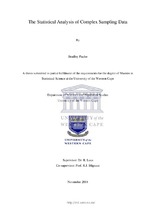| dc.description.abstract | Most standard statistical techniques illustrated in text books assume that the data are collected from a simple random sample (SRS) and hence are independently and identically distributed (i.i.d.). In reality, data are often sourced through complex sampling (CS) designs, with a combination of stratification and clustering at different levels of the design. Consequently, the CS data are not i.i.d. and sampling weights that are developed over different stages, are calculated and included in the analysis of this data to account for the sampling design. Logistic regression is often employed in the modelling of survey data since the response under investigation typically has a dichotomous outcome. Furthermore, since the logistic regression model has no homogeneity or normality assumptions, it is appealing when modelling a dichotomous response from survey data.
This research considers the comparison of the estimates of the logistic regression model parameters when the CS design is accounted for, i.e. weighting is present, to when the data are modelled using an SRS design, i.e. no weighting. In addition, the standard errors of the estimators will be obtained using three different variance techniques, viz. Taylor series linearization, the jackknife and the bootstrap. The different estimated standard errors will be used in the calculation of the standard (asymptotic) interval which will be compared to the bootstrap percentile interval in terms of the interval coverage probability. A further level of comparison is obtained when using only design weights to those obtained using calibrated and integrated sampling weights. This simulation study is based on the Income and Expenditure Survey (IES) of 2005/2006. The results showed that generally when weighting was used the estimators performed better as opposed to when the design was ignored, i.e. under the assumption of SRS, with the results for the Taylor series linearization being more stable. | en_US |

